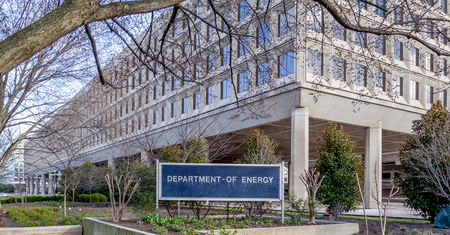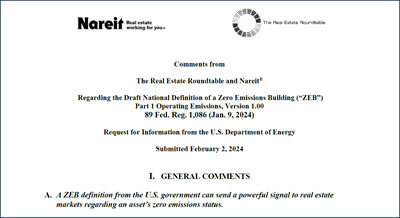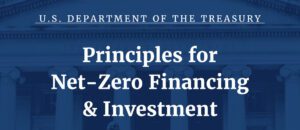
The Real Estate Roundtable (RER) and Nareit submitted comments today to the U.S. Department of Energy (DOE) on its draft definition for Zero Emissions Buildings (ZEB). DOE’s initiative would impose no federal mandates while showing U.S. leadership on climate policy. (Joint comments cover letter and addendum | Roundtable Weekly, Jan. 5)
A “Path to ZEB”
- The ZEB national definition aims to set voluntary criteria that could help building owners provide auditable, consistent statements to investors, tenants, and policy makers about long-term aspirations for a building’s decarbonization. (DOE announcement | National Definition Draft)
- The RER/Nareit comments emphasize that few buildings today could meet zero emissions status. Rather, the ZEB definition can be a guideline to support lifecycle investments when boilers, water heaters, and other systems reliant on fossil fuels reach the end of their lives after years of use. (Joint comments cover letter and addendum)
- Concrete actions that owners can take now to show an asset is “on the path” to zero emissions status are key to ZEB’s success as a long-term goal.
- The joint comments urge DOE to recognize “NextGen”—the imminent label for low-carbon buildings from the Environmental Protection Agency (EPA)—as the intermediate step for a building that aspires to reach ZEB status.
- EPA plans to make NextGen building certifications available later this year. EPA unveiled final NextGen criteria, also voluntary, at a meeting of RER’s Sustainability Policy Advisory Committee (SPAC) last week in Washington, D.C. (Roundtable Weekly, Jan. 26 and EPA’s Presentation on NextGen to SPAC)
Comments on the National ZEB Definition

Topline points from the RER/Nareit comments (cover letter and addendum) include:
- ZEB should provide ambitious but attainable policy for individual buildings and portfolios, residential and commercial, across product types.
- DOE’s national definition should be leveraged to bring consistency and uniformity to the patchwork of building related climate programs, which are imposed by state and local performance standards and pushed by international frameworks. (Roundtable Weekly, Sept. 15 and RER’s Climate and Energy Priorities, Jan. 2024)
- DOE should not re-invent the wheel. It should align the ZEB definition with the ecosystem of federal data, methods, and guides that already pertain to buildings.
- ZEB’s general nationwide definition must consider regional variables such as the climate and electric grid conditions pertinent to where a building is located.
- The definition’s success depends on consistent methods for building owners to measure energy use and emissions. ZEB must reflect metrics tracked in Portfolio Manager, EPA’s free online software. (Roundtable Weekly, Sept. 15 and EPA’s Portfolio Manager Upgrade Project)
- A “zero” emissions standard requires a reasonable exclusion of emissions from emergency power generators. This exclusion to protect health and safety is necessary for building operations to continue when the electric grid fails.
- Many buildings have physical and regulatory restrictions that preclude onsite solar panels, wind turbines, and battery storage. DOE’s draft correctly permits valid and credible “market-based” measures, such as the purchase of renewable energy certificates (“RECs”), to meet the definition’s renewable energy criteria.
A final ZEB definition is expected later this year. The real estate sector also awaits final climate risk corporate disclosure rules this spring from the U.S. Securities and Exchange Commission. (Roundtable Weekly, Jan. 12)
# # #














